1996 CHEVROLET BLAZER stop start
[x] Cancel search: stop startPage 178 of 392
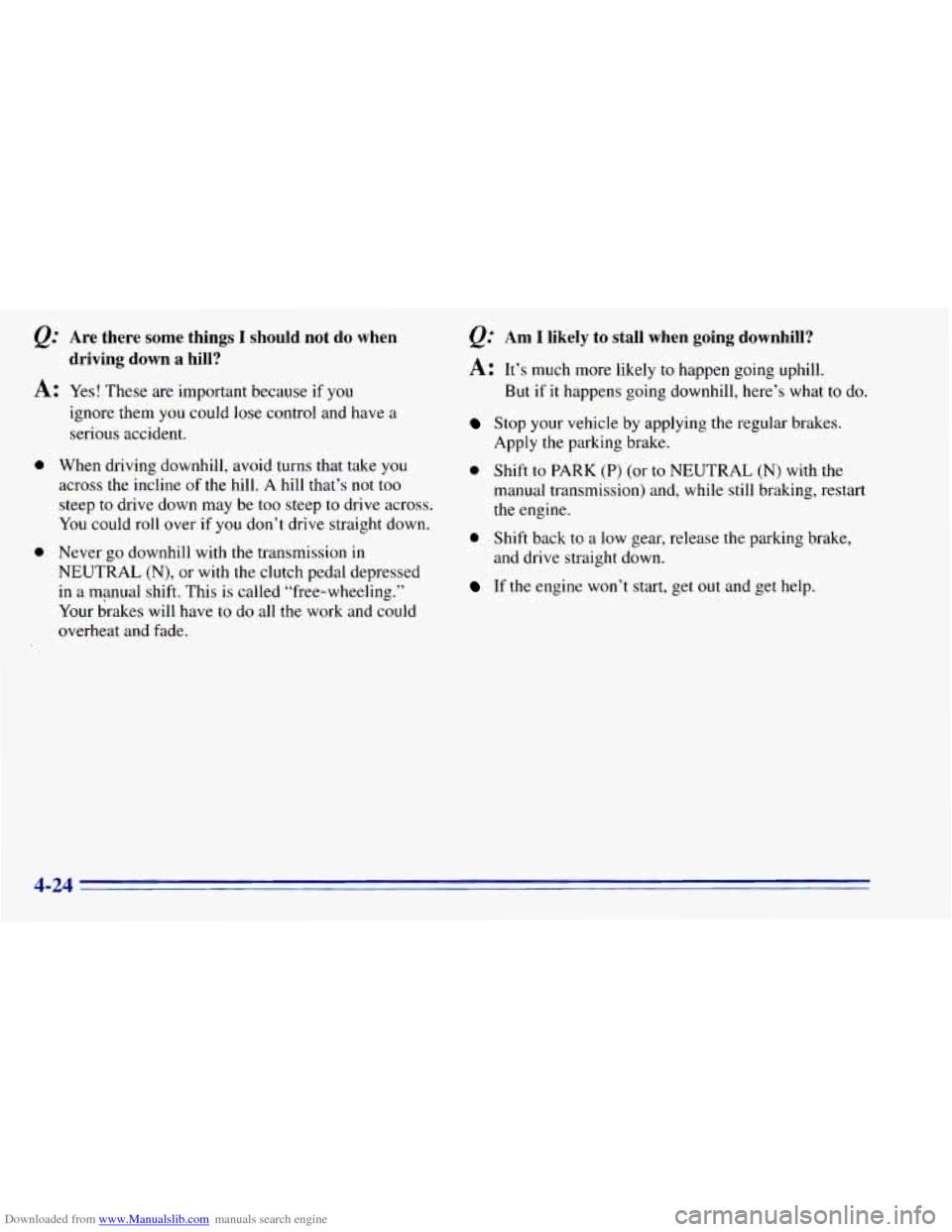
Downloaded from www.Manualslib.com manuals search engine Q: Are there some things I should not do when
A: Yes! These are important because if you
driving down a hill?
0
ignore them you could lose control and have a
serious accident.
When driving downhill, avoid turns that take you
across the incline
of the hill. A hill that’s not too
steep to drive down may be too steep to drive across.
You could roll over if you don’t drive straight down.
Never go downhill with
the transmission in
NEUTRAL (N), or with the clutch pedal depressed
in
a manual shift. This is called “free-wheeling.”
Your brakes will have to
do all the work and could
overheat and fade.
@’ Am I likely to stall when going downhill?
A: It’s much more likely to happen going uphill.
But if it happens going downhill, here’s what to do.
Stop your vehicle by applying the regular brakes.
0 Shift to PARK (P) (or to NEUTRAL (N) with the
Apply the parking brake.
manual transmission) and, while still braking, restart
the engine.
0 Shift back to a low gear, release the parking brake,
If the engine won’t start, get out and get help.
and
drive straight down,
4-24
Page 180 of 392
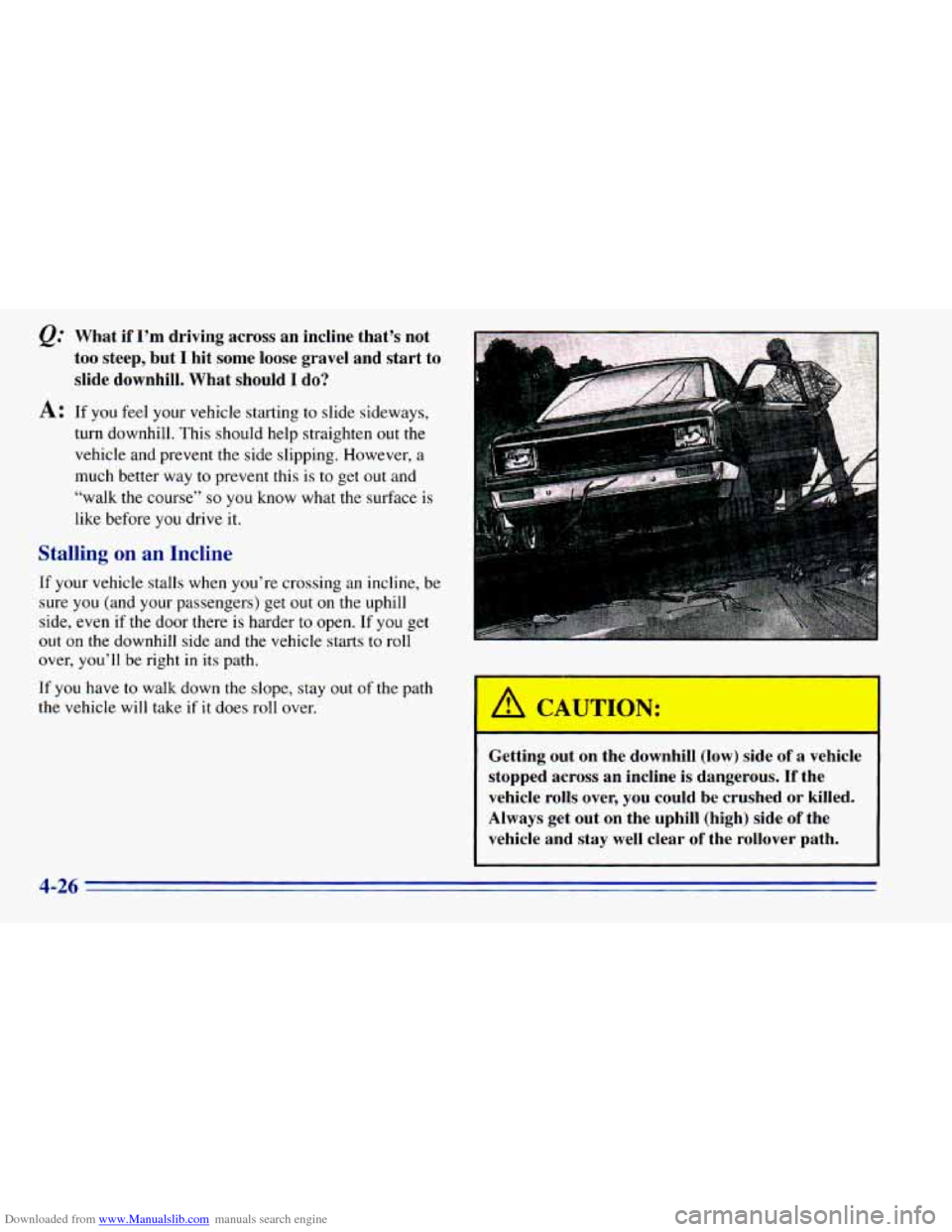
Downloaded from www.Manualslib.com manuals search engine &: What if I’m driving across an incline that’s not
too steep, but
I hit some loose gravel and start to
slide downhill. What should
I do?
A: If you feel your vehicle starting to slide sideways,
turn downhill. This should help straighten out the
vehicle and prevent the side slipping. However, a
much better way to prevent this is to get out and
“walk the course”
so you know what the surface is
like before you drive it.
Stalling on an Incline
If your vehicle stalls when you’re crossing an incline, be
sure you (and your passengers) get out
on the uphill
side, even if the door there is harder to open.
If you get
out on the downhill side and the vehicle starts to roll
over, you’ll be right in its path.
If you have to walk down the slope, stay out of the path
the vehicle will take if it does roll over.
- . ,. .. ,,
A CAUTION:
.. .. .. , . ’_ ..:.
Getting out on the downhill (low) side of a vehicle
stopped across an incline is dangerous.
If the
vehicle rolls over, you could be crushed
or killed.
Always get out on the uphill (high) side of the
vehicle and stay well clear
of the rollover path.
Page 182 of 392
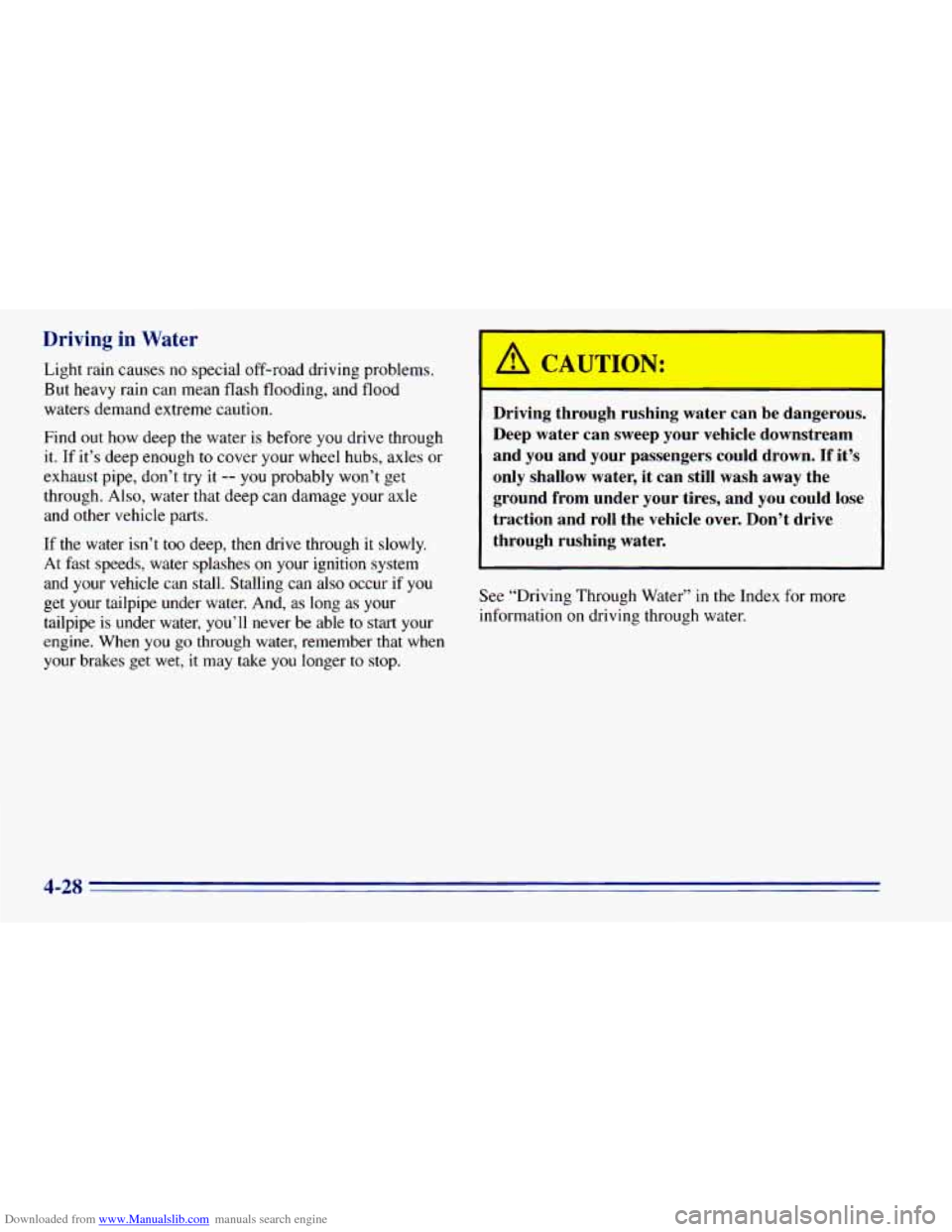
Downloaded from www.Manualslib.com manuals search engine Driving in Water
Light rain causes no special off-road driving problems.
But heavy rain can mean flash flooding, and flood
waters demand extreme caution.
Find out how deep the water is before you drive through
it. If it’s deep enough to cover your wheel hubs, axles or
exhaust pipe, don’t
try it -- you probably won’t get
through. Also, water that deep can damage your axle
and other vehicle parts.
If the water isn’t too deep, then drive through
it slowly.
At fast speeds, water splashes on your ignition system
and your vehicle can stall. Stalling can also occur if you
get
your tailpipe under water. And, as long as your
tailpipe is under water, you’ll never be able to start your\
engine. When you go through water, remember that when
your brakes get wet,
it may take you longer to stop.
I
A CAUTION:
~ Driving through rushing water can be dangerous.
Deep
water can sweep your vehicle downstream
and you and your passengers could drown.
If it’s
only shallow water, it can still wash away the ground from under your tires, and you could lose
traction and roll the vehicle over. Don’t drive
through rushing water.
See “Driving Through Water”
in the Index for more
information on driving through water.
4-28
Page 185 of 392
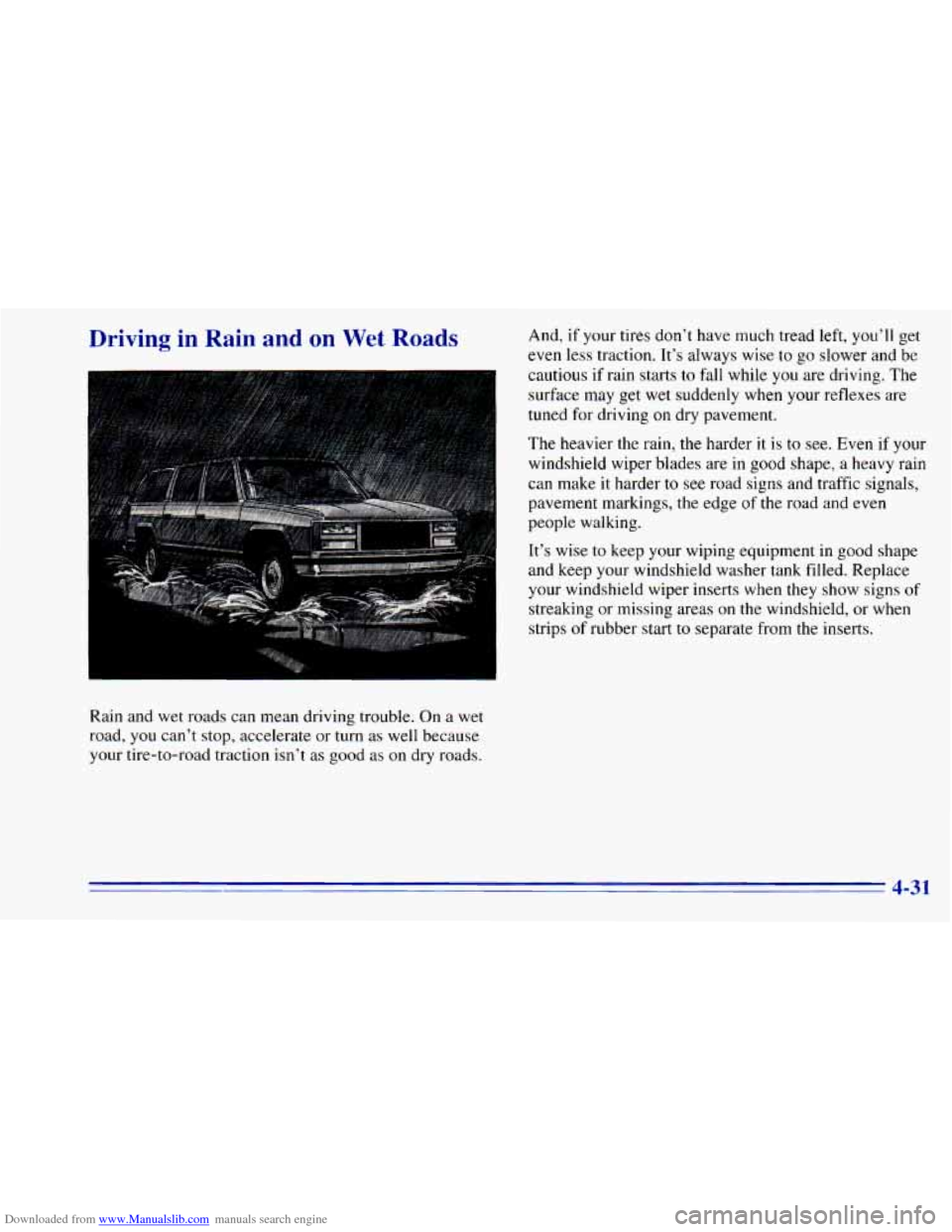
Downloaded from www.Manualslib.com manuals search engine Driving in Rain and on Wet Roads
I
Rain and wet roads can mean driving trouble. On a wet
road, you can't stop, accelerate or turn as well because
your tire-to-road traction isn't as good as
on dry roads. And,
if your tires don't have much tread left, you'll get
even less traction. It's always wise to go slower and be
cautious
if rain starts to fall while you are driving. The
surface may
get wet suddenly when your reflexes are
tuned for driving
on dry pavement.
The heavier the rain,
the harder it is to see. Even if your
windshield wiper blades are in
good shape, a heavy rain
can make
it harder to see road signs and traffic signals,
pavement markings, the edge
of the road and even
people walking.
It's wise
to keep your wiping equipment in good shape
and keep your windshield washer tank filled. Replace
your windshield wiper inserts when they show signs
of
streaking or missing areas on the windshield, or when
strips
of rubber start to separate from the inserts.
4-3 1
Page 190 of 392
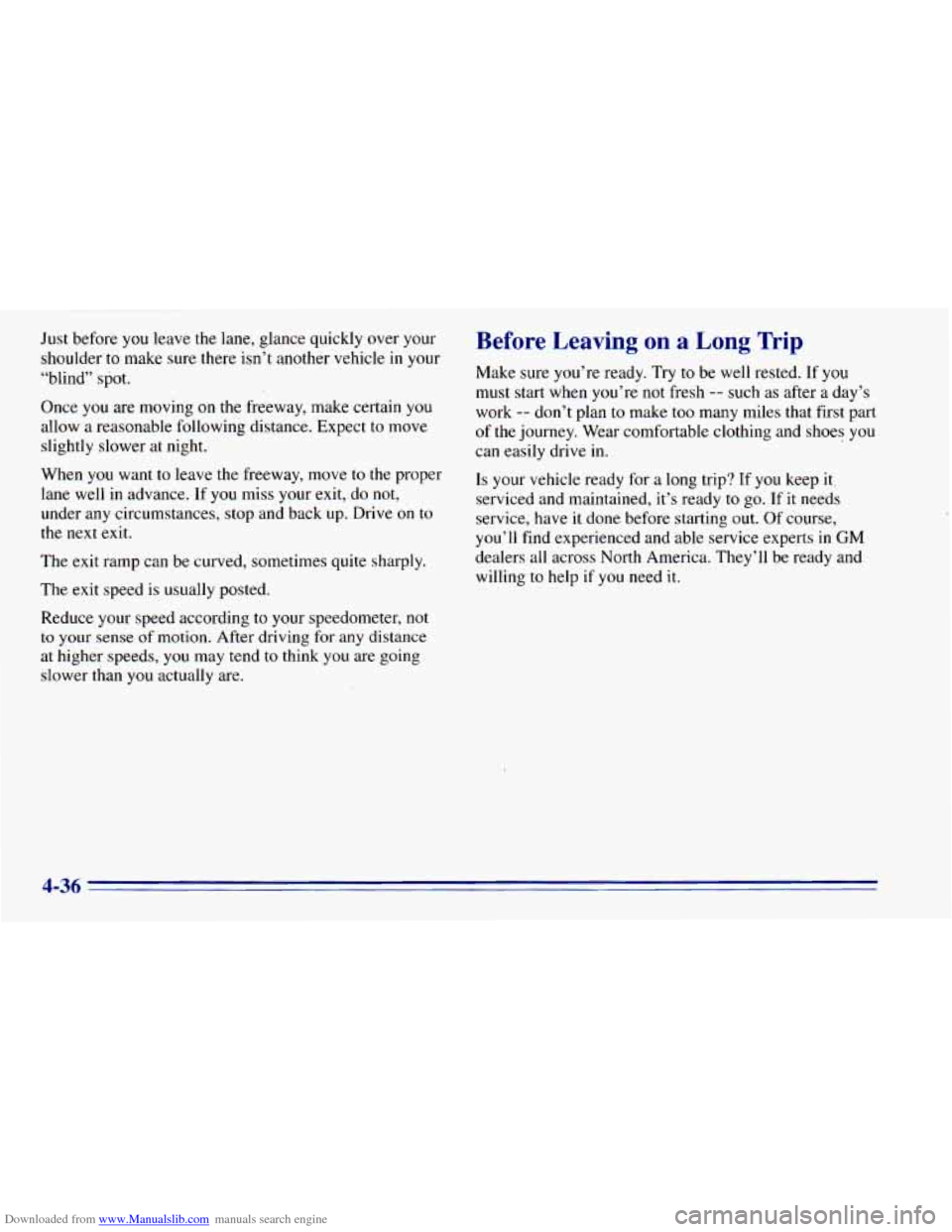
Downloaded from www.Manualslib.com manuals search engine Just before you leave the lane, glance quickly over your
shoulder to make sure there isn’t another vehicle in your
“blind” spot.
Once you are moving on the freeway, make certain
you
allow a reasonable following distance. Expect to move
slightly slower at night.
When you want
to leave the freeway, move to the proper
lane well in advance. If you miss your exit, do not,
under any circumstances, stop and back up. Drive on
to
the next exit,
The exit ramp can be curved, sometimes quite sharply.
The exit speed is usually posted.
Reduce
your speed according to your speedometer, not
to your sense of motion. After driving for any distance
at higher speeds, you may tend
to think you are going
slower than you actually are.
Before Leaving on a Long Trip
Make sure you’re ready. Try to be well rested. If you
must start when you’re not fresh
-- such as after a day’s
work
-- don’t plan to make too many miles that first part
of the journey. Wear comfortable clothing and shoes you
can easily drive in.
Is your vehicle ready for a long trip? If you keep it,
serviced and maintained, it’s ready
to go. If it needs
service, have it done before starting out. Of course,
you’ll find experienced and able service experts in
GM
dealers all across North America. They’ll be ready and
willing to help
if you need it.
4-36
Page 207 of 392
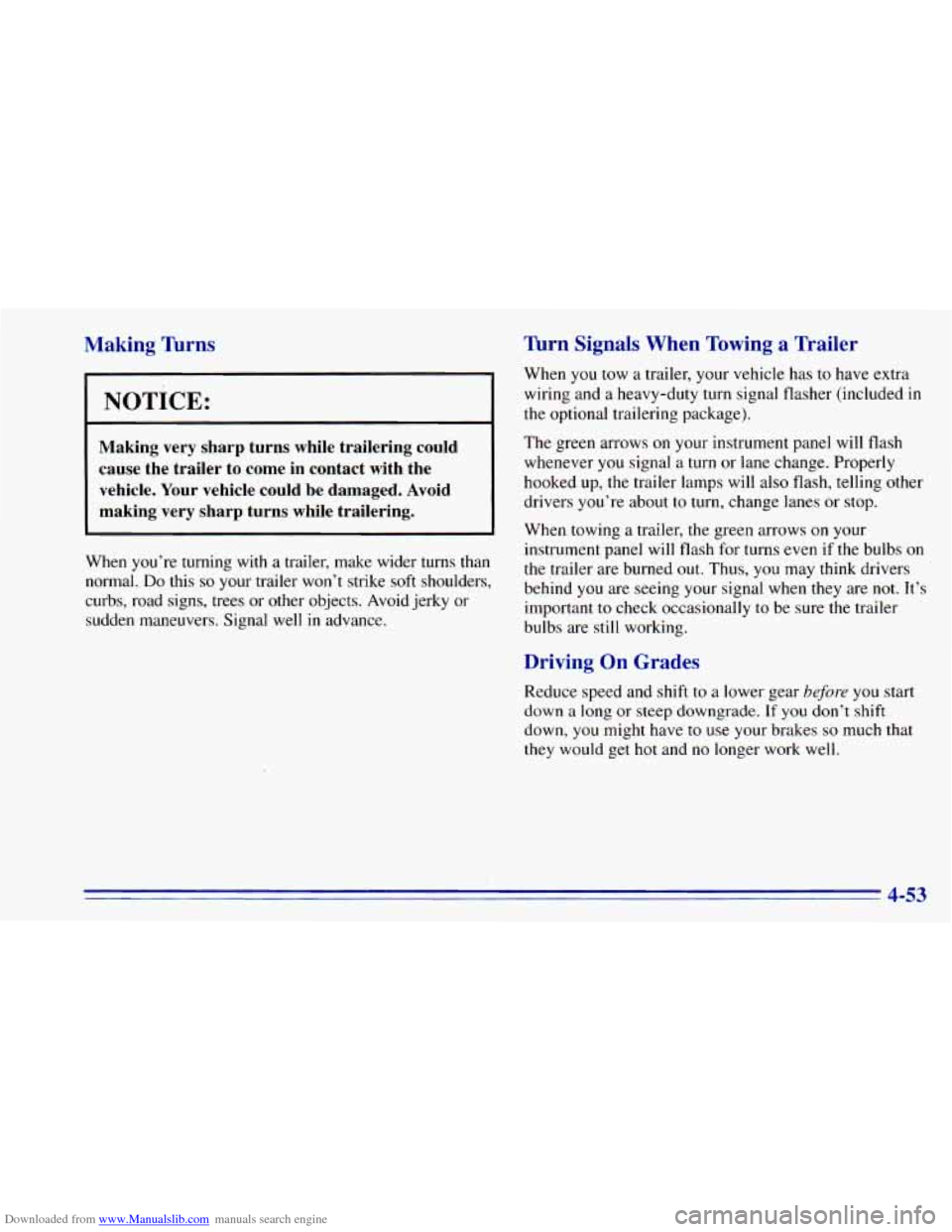
Downloaded from www.Manualslib.com manuals search engine Making lhrns
NOTICE:
Making very sharp turns while trailering could
cause the trailer to come in contact with the
vehicle. Your vehicle could
be damaged. Avoid
making very sharp turns while trailering.
When you’re turning with a trailer, make wider turns than
normal.
Do this so your trailer won’t strike soft shoulders,
curbs, road signs, trees or other objects. Avoid jerky or
sudden maneuvers. Signal well in advance.
Turn Signals When Towing a Trailer
When you tow a trailer, your vehicle has to have extra
wiring and a heavy-duty turn signal flasher (included
in
the optional trailering package).
The green arrows
on your instrument panel will flash
whenever you signal a turn or lane change. Properly
hooked up, the trailer lamps will also
flash, telling other
drivers you’re about to turn, change lanes or stop.
When towing a trailer, the green arrows
on your
instrument panel will flash for turns
even if the bulbs on
the trailer are burned out. Thus, you may think drivers
behind
you are seeing your signal when they are not. It’s
important
to check occasionally to be sure the trailer
bulbs are still working.
Driving On Grades
Reduce speed and shift to a lower gear before you start
down a long or steep downgrade.
If you don’t shift
down,
you might have to use your brakes so much that
they would get hot and
no longer work well.
4-53
Page 209 of 392
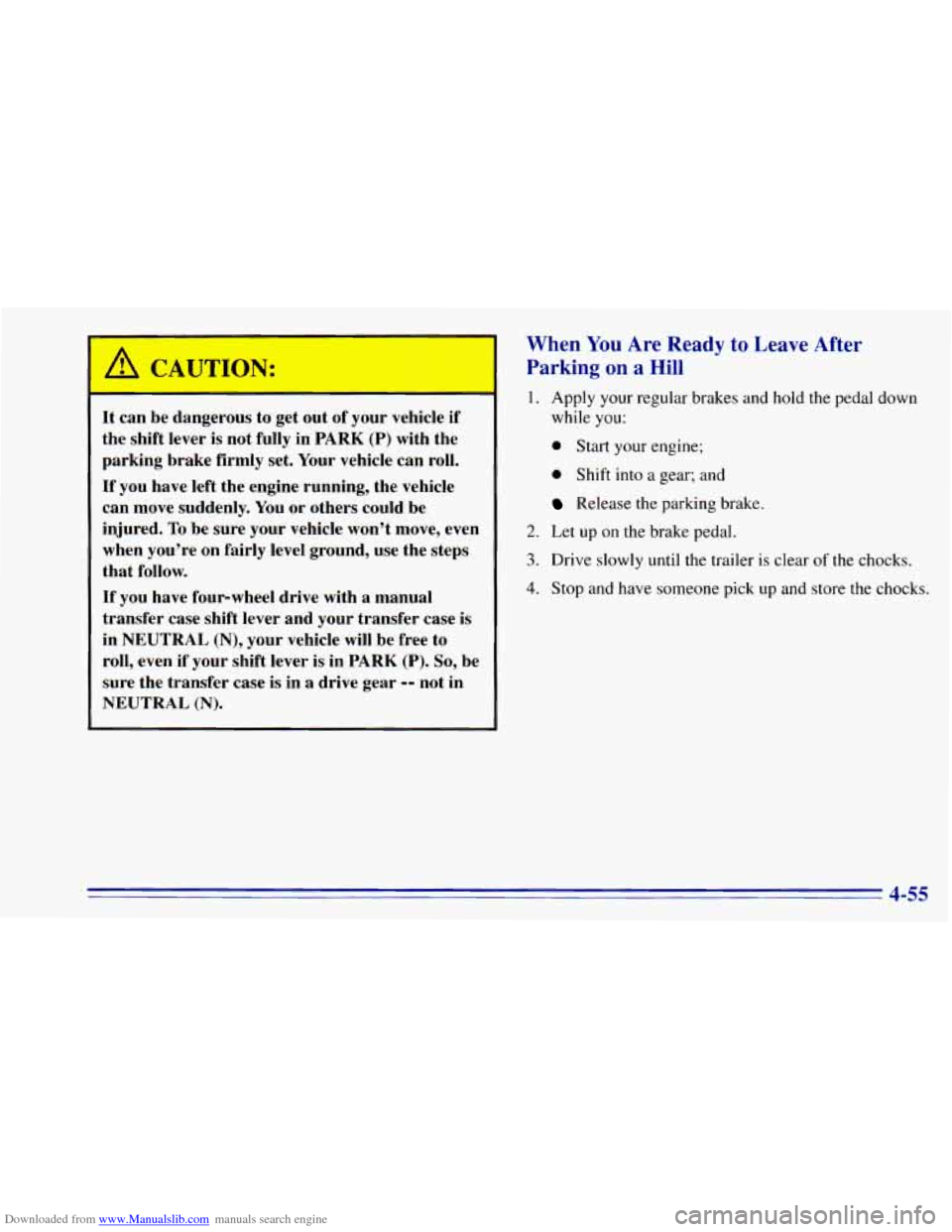
Downloaded from www.Manualslib.com manuals search engine A CAUTION:
- - -
It can be dangerous to get out of your vehicle if
the shift lever is not fully in
PARK (P) with the
parking brake firmly set. Your vehicle can roll.
If you have left the engine running, the vehicle
can move suddenly. You or others could be
injured.
To be sure your vehicle won’t move, even
when you’re on fairly level ground, use the steps
that follow.
If you have four-wheel drive with a manual
transfer case shift lever and your transfer case is
in
NEUTRAL (N), your vehicle will be free to
roll, even if your shift lever is in
PARK (P). So, be
sure the transfer case is in a drive gear
-- not in
NEUTRAL (N).
When You Are Ready to Leave After
Parking on
a Hill
1. Apply your regular brakes and hold the pedal down
while you:
0 Start your engine;
0 Shift into a gear; and
Release the parking brake.
2. Let up on the brake pedal.
3. Drive slowly until the trailer is clear of the chocks.
4. Stop and have someone pick up and store the chocks.
4-55
Page 210 of 392
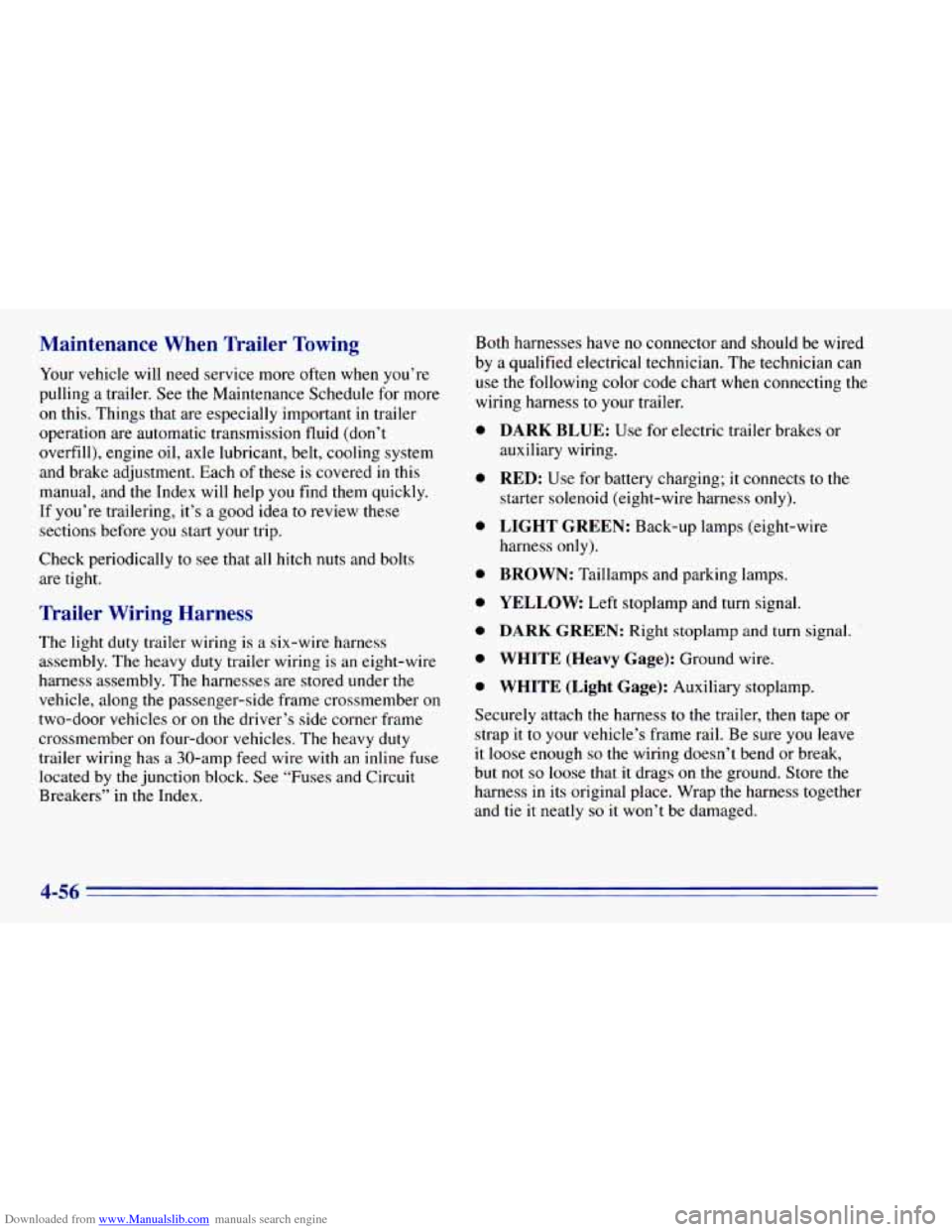
Downloaded from www.Manualslib.com manuals search engine Maintenance When Trailer Towing
Your vehicle will need service more often when you’re
pulling
a trailer. See the Maintenance Schedule for more
on this. Things that are especially important in trailer
operation are automatic transmission fluid (don’t
overfill), engine oil, axle lubricant, belt, cooling system
and brake adjustment. Each of these is covered
in this
manual, and the Index will help you find them quickly.
If you’re trailering, it’s a good idea to review these
sections before you start your trip.
Check periodically to see that all hitch nuts and bolts
are tight.
Trailer Wiring Harness
The light duty trailer wiring is a six-wire harness
assembly. The heavy duty trailer wiring is an eight-wire
harness assembly. The harnesses are stored under
the
vehicle, along the passenger-side frame crossmember on
two-door vehicles or on the driver’s side corner frame
crossmember
on four-door vehicles. The heavy duty
trailer wiring has a 30-amp feed wire with an inline fuse
located by the junction block. See “Fuses and Circuit
Breakers” in
the Index. Both harnesses have no
connector and should be wired
by a qualified electrical technician. The technician can
use the following color code chart when connecting the
wiring harness
to your trailer.
0
0
0
0
0
0
0
0
DARK BLUE: Use for electric trailer brakes or
auxiliary wiring.
RED: Use for battery charging; it connects to the
starter solenoid (eight-wire harness
only).
LIGHT GREEN: Back-up lamps (eight-wire
harness only).
BROWN: Taillamps and parking lamps.
YELLOW Left stoplamp and turn signal.
DARK GREEN: Right stoplamp and turn signal.
WHITE (Heavy Gage): Ground wire.
WHITE (Light Gage): Auxiliary stoplamp.
Securely attach the harness
to the trailer, then tape or
strap it to your vehicle’s frame rail. Be sure you leave
it loose enough
so the wiring doesn’t bend or break,
but
not so loose that it drags on the ground. Store the
harness in its original place. Wrap the harness together
and
tie it neatly so it won’t be damaged.
4-56